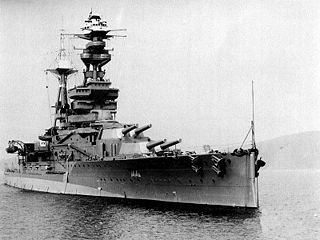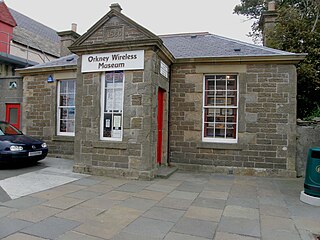
Hoy is an island in Orkney, Scotland, measuring 143 square kilometres (55 sq mi) – the second largest in the archipelago, after Mainland. A natural causeway, the Ayre, links the island to the smaller South Walls; the two islands are treated as one entity by the UK census.

HMS Hampshire was one of six Devonshire-class armoured cruisers built for the Royal Navy in the first decade of the 20th century. She was assigned to the 1st Cruiser Squadron of the Channel Fleet upon completion. After a refit, she was assigned to the reserve Third Fleet in 1909 before going to the Mediterranean Fleet in 1911. She was transferred to the China Station in 1912 and remained there until the start of the First World War in August 1914.

Scapa Flow is a body of water in the Orkney Islands, Scotland, sheltered by the islands of Mainland, Graemsay, Burray, South Ronaldsay and Hoy. Its sheltered waters have played an important role in travel, trade and conflict throughout the centuries. Vikings anchored their longships in Scapa Flow more than a thousand years ago. It was the United Kingdom's chief naval base during the First and Second World wars, but the facility was closed in 1956.

Captain Henry Lockhart St John Fancourt was a British pioneering naval aviator, and held important aviation commands with the Fleet Air Arm during the Second World War. When Fancourt died at the age of 103, he was one of the last, if not the last, survivor who had actively been involved in the Battle of Jutland.

Flotta is a small island in Orkney, Scotland, lying in Scapa Flow. The island is known for its large oil terminal and is linked by Orkney Ferries to Houton on the Orkney Mainland, Lyness on Hoy and Longhope on South Walls. The island has a population of 80.

HMS Royal Oak was one of five Revenge-class battleships built for the Royal Navy during the First World War. Completed in 1916, the ship first saw combat at the Battle of Jutland as part of the Grand Fleet. In peacetime, she served in the Atlantic, Home and Mediterranean fleets, more than once coming under accidental attack. Royal Oak drew worldwide attention in 1928 when her senior officers were controversially court-martialled, an event that brought considerable embarrassment to what was then the world's largest navy. Attempts to modernise Royal Oak throughout her 25-year career could not fix her fundamental lack of speed and, by the start of the Second World War, she was no longer suitable for front-line duty.

HMS Vanguard was one of three St Vincent-class dreadnought battleships built for the Royal Navy in the first decade of the 20th century. She spent her career assigned to the Home and Grand Fleets. Aside from participating in the Battle of Jutland in May 1916 and the inconclusive action of 19 August several months later, her service during World War I mostly consisted of routine patrols and training in the North Sea.

The Grand Fleet was the main battlefleet of the Royal Navy during the First World War. It was established in August 1914 and disbanded in April 1919. Its main base was Scapa Flow in the Orkney Islands.
Gutter Sound is a sound in Orkney, Scotland, part of Scapa Flow. It lies to the west of the main harbour between the internal islands of Cava and Fara, and the large outer island of Hoy. Gutter Sound was one of the sites of the scuttling of the interned Imperial German High Seas Fleet in 1919, and the scene of a major salvage operation in the 1920s. The remaining wrecks are frequently visited by recreational divers.

HMS Erin was a dreadnought battleship of the Royal Navy, originally ordered by the Ottoman government from the British Vickers Company. The ship was to have been named Reşadiye when she entered service with the Ottoman Navy. The Reşadiye class was designed to be at least the equal of any other ship afloat or under construction. When the First World War began in August 1914, Reşadiye was nearly complete and was seized at the orders of Winston Churchill, the First Lord of the Admiralty, to keep her in British hands and prevent her from being used by Germany or German allies. There is no evidence that the seizure played any part in the Ottoman government declaring war on Britain and the Triple Entente.

HMS Caroline is a decommissioned C-class light cruiser of the Royal Navy that saw combat service in the First World War and served as an administrative centre in the Second World War. Caroline was launched and commissioned in 1914. At the time of her decommissioning in 2011 she was the second-oldest ship in Royal Navy service, after HMS Victory. She served as a static headquarters and training ship for the Royal Naval Reserve, based in Alexandra Dock, Belfast, Northern Ireland, for the later stages of her career. She was converted into a museum ship. From October 2016 she underwent inspection and repairs to her hull at Harland and Wolff and opened to the public on 1 July 2017 at Alexandra Dock in the Titanic Quarter in Belfast.

The Churchill Barriers are four causeways in the Orkney islands with a total length of 2.3 kilometres (1.4 mi). They link the Orkney Mainland in the north to the island of South Ronaldsay via Burray and the two smaller islands of Lamb Holm and Glimps Holm.
The 6th Battle Squadron was a squadron of the British Royal Navy consisting of Battleships serving in the Grand Fleet and existed from 1913 to 1917.

Lyness is a village on the east coast of the island of Hoy, Orkney, Scotland. The village is within the parish of Walls and Flotta, and is situated at the junction of the B9047 and B9048.

Rear-Admiral Henry Evelyn Charles Blagrove was the first British Royal Navy officer of flag rank to be killed in the Second World War. An experienced staff officer and veteran of several actions of the First World War aboard the battlecruiser HMS Tiger, Blagrove had only just received his appointment as commander of the 2nd Battleship Squadron of the Home Fleet when he was killed in the destruction of his flagship HMS Royal Oak by German submarine U-47.

Royal Naval Air Station Hatston, was a Royal Naval Air Station, one mile to the north west of Kirkwall on the island of Mainland, Orkney, Scotland. It was located near the strategically vital naval base of Scapa Flow, which for most of the twentieth century formed the main base of the ships of the Home Fleet. The airbase was designed to provide accommodation for disembarked Front-Line squadrons and accommodation for disembarked Ship's Flight Aircraft and was home to the Home Fleet Fleet Requirements Unit, 771 Naval Air Squadron.

The Orkney Wireless Museum in Kirkwall, Orkney, Scotland, houses a collection of domestic and military wireless equipment. It developed from the private collection of the late Jim MacDonald from St Margaret's Hope and marks the importance of wireless communications in Orkney during World War II.

Several Royal Navy ships have borne the name HMS Proserpine:

Ness Battery is a coastal defence battery in Stromness, Orkney. It was a crucial element of the defences of the western entrance to Scapa Flow, in the Orkney Islands, Scotland, the main fleet base for the Royal Navy in both World Wars. Several of the original wooden huts which formed the accommodation camp are still intact, and in one of these is a painted mural covering three walls, depicting rural English scenes. An extensive programme of stabilisation and renovation took place from 2009, and was completed in 2012, and the site is now open for guided tours.
The Admiral Commanding, Orkneys and Shetlands was an operational commander of the Royal Navy. He was charged with the administration of the Orkney and Shetland Islands and operating and defending the fleet base at Scapa Flow that was the main anchorage for both the Home Fleet and Grand Fleet at various times.


















